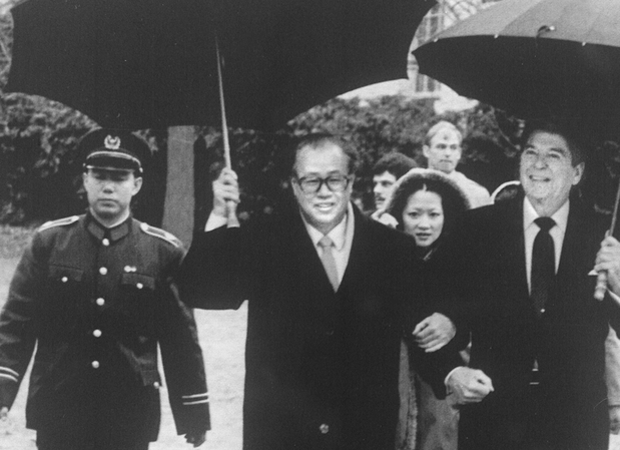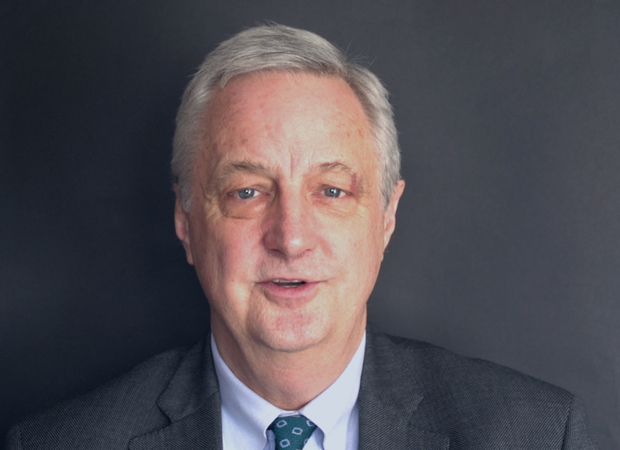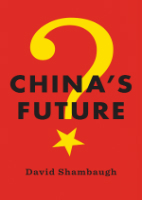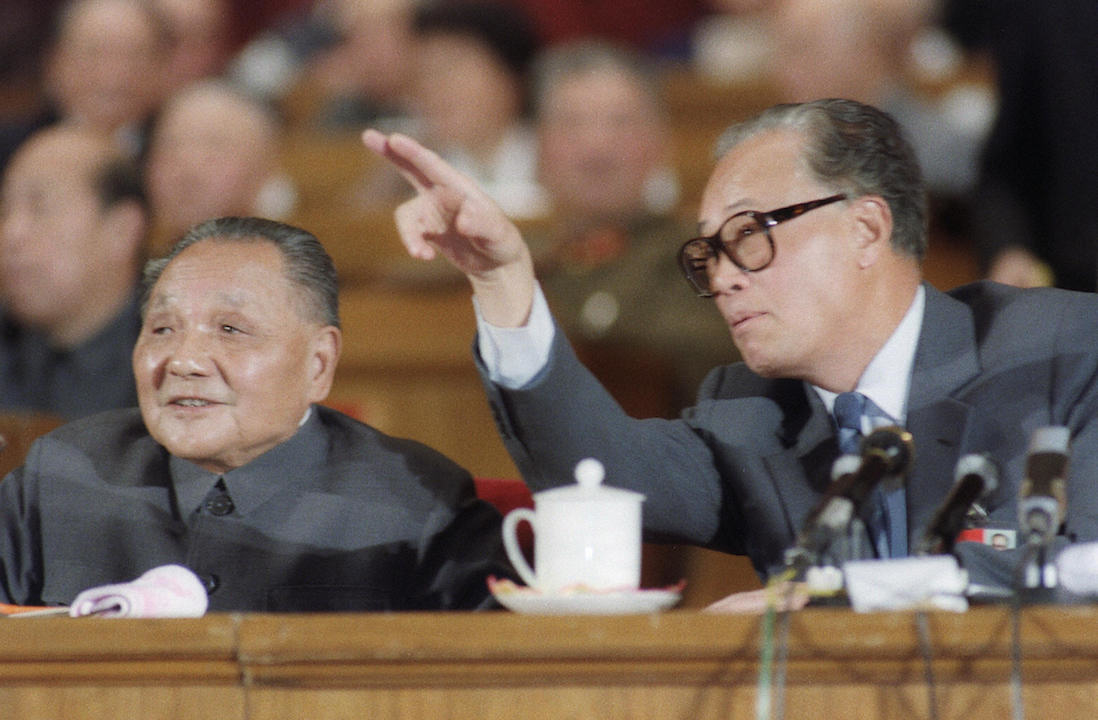It is difficult to say with any certainty how China would have evolved had Zhao Ziyang not been overthrown in 1989. The ostensible cause of his purge was his refusal to endorse martial law and authorize the use of force to suppress the Tiananmen demonstrations (thus “splitting the Party”)—but even before that fateful Politburo meeting and his final public appearance in the square during the early morning hours of May 19, 1989, Zhao was locked in intense factional struggle with Li Peng, Yang Shangkun, and arch-conservative elders Wang Zhen and Deng Liqun. His grip on ultimate power was never firm after he succeeded the deposed Hu Yaobang as Communist Party general secretary in 1987. Even Deng Xiaoping was wobbly in his support for Zhao and his proposed reforms during and after the Thirteenth Party Congress that year. Without Deng’s clear support—behind the scenes and publicly—Zhao’s political vulnerability was exposed. During this two-year period (1987-1989), the conservatives smelled blood and did all they could to block Zhao’s reforms and undermine his position.
In this context, Zhao may not have survived politically even if the Tiananmen events had not transpired. Zhao and the conservatives disagreed about the nature of economic reforms at the time (recall the overheating of the economy in 1988), and they certainly disagreed over political reform. At a minimum, Zhao would have been locked in intense factional struggle and this quite likely would have compromised his ability to implement his bold economic and political reform package. As Julian Gewirtz correctly notes in his commentary, the comprehensive four-volume set of Zhao’s speeches and documents recently published by the Chinese University Press in Hong Kong delineates in considerable detail where Zhao was trying to take China (particularly when read in conjunction with Prisoner of the State: The Secret Journal of Premier Zhao Ziyang and The Tiananmen Papers).
Conversation
08.18.16
What Would China Look Like Today Had Zhao Ziyang Survived?
In essence, Zhao’s vision for China was one of simultaneous economic and political reform. He explicitly rejected the view that economic reform had to precede political reform or that political reform was not necessary. In this regard, he held the same view as Mikhail Gorbachev, which was amply evident in their May 16, 1989 public meeting in the Great Hall of the People. Had Zhao remained in power and been able to pursue this twin-reform strategy, it is an open question whether he and China would have wound up with the same fate as Gorbachev and the former Soviet Union—or whether this strategy would have worked in China, where it did not in the U.S.S.R. The main reasons for such conjecture are that China’s economy was far more reformed and integrated into the international economy than the Soviet Union was (and thus on much stronger footing), and that Zhao’s model of political reform for China was one of “neo-authoritarianism” along the lines of Singapore plus de facto federalism (Zhao’s advisor Yan Jiaqi’s brainchild) that would fiscally empower provinces rather than maintain the central government as the controlling organ and rent-seeker. Zhao’s political model would also likely have permitted much more open civil society and media; tolerated some dissent; enfranchised the eight so-called “democratic parties” and empowered the National People’s Congress and provincial people’s congresses; established a Hong Kong-style professional civil service (Zhao studied this carefully and had embarked on this reform when he was overthrown); separated Party from government (dang-zheng fenkai); made the military beholden to the state and constitution rather than a tool of the Communist Party; more strictly controlled opportunities for corruption and strengthened the non-Party control mechanisms; encouraged greater “inner party” feedback mechanisms; and proceeded with gradual direct government elections up to and including central-level officials.
This is my sense of where Zhao Ziyang was headed. It may have worked—and if it had, China would have been far better off for it.
The reason I say this is because many of the pressures China currently faces—from the ossified Party-state to the public sphere to the state sector of the economy—would have been dealt with and ameliorated back in the 1990s. But they were not and, as a result, they have metastasized and China’s political system today remains a major—if not the—principal constraint on the country’s further development.
Books
04.18.16

China’s Future
When one considers the path of the Chinese economy since Zhao’s downfall, my sense is that there would also have been some significant differences in the ways in which China has developed since 1989. With the advantage of hindsight, Zhao would have supported much of the development strategy of the 1990s-2000s, and he would have supported the spirit of Deng’s 1992 Southern Sojourn which stimulated local state corporatism and entrepreneurship. But my sense is that Zhao also would have embraced widespread privatization of state assets and the robust expansion of the private sector much earlier than has occurred. He would likely have dismantled much of the state-owned enterprise system (probably using many of the same approaches Zhu Rongji later adopted). Zhao was also not as enamored with the Northeast Asian developmental state model of development (that promoted large conglomerates) as with a more Southeast Asian small- and medium-enterprise model. Perhaps this came from his lengthy tenure in Guangdong and travels in Southeast Asia. Zhao was also very open to a wide range of pragmatic hybrid solutions to various economic problems—he was not an ideologue, but a pragmatic and progressive reformer. Sometimes he moved too aggressively, as with price reforms in 1987-1988, but he was not wed to policies when they did not work. He believed deeply in experimentation, material incentives, and tying remuneration to the quality of production. As Zhao stated in a 1981 interview: “Socialism means two things: public ownership of the means of production and paying each according to his work. As long as these two principles are safeguarded, we should feel free to adopt all those structures, systems, policies, and measures which can promote the development of production and not bind ourselves as silkworms do in cocoons.” (“The Sichuan Experiment with Enterprises,” Beijing Review, No. 14, April 6, 1981) So, while Zhao would likely have supported some of the post-1992 development model (mainly export processing), I think his economic thinking was actually far more bold and far-reaching than those policies his successors adopted.
Of course, this is all speculative and history took a very different turn in 1989. Zhao Ziyang paid the price professionally and personally, living out the rest of his life under isolated house arrest. Since his purge, as is standard operating procedure in the Party, Zhao’s lifelong contributions to the nation and his time at the top of the system as premier and general secretary have been whitewashed from official history. Unlike Hu Yaobang, Zhao has not even enjoyed a partial posthumous “rehabilitation.” That is why this new four-volume set of Zhao’s internal speeches and documents is so important. While it is highly doubtful that the collection will circulate inside mainland China, at least now it is available worldwide. Let us hope that it works its way into China and that it may produce some correction of official historical distortion and a “rectification of verdicts”, as a regime and nation that cannot be honest about its own past is severely handicapped in facing the future.
Finally, we must remember that Zhao was no Johnny-Come-Lately reformer. My first book, a biography of Zhao’s provincial career prior to his elevation to Beijing, elucidates the same policy proclivities that he brought to Beijing when he was elevated to the premiership in 1980.
Zhao’s legacy as a provincial-level reformer was consistent. As early as 1957, Zhao experimented with the agricultural reforms that would become the blueprint for the Deng era in the 1980s: the so-called “responsibility” system that emphasized private plots, private markets, production contracts for households, and permitting peasants to engage in tertiary light industry. Zhao revived these methods in 1964-1965, which permitted the Chinese countryside to overcome the Mao-inspired “Great Leap Forward” that had killed 30 million in the rural areas. After his purge and rehabilitation during the Cultural Revolution, Deng arranged for Zhao to institute the same agricultural program in populous Sichuan province (which had 80 million rural peasants at the time). It was so successful that the peasants there coined a pun on Zhao’s name: “If you want to eat, look for (zhao) Ziyang” (“zhao” being a homonym for “to look”). Zhao’s rural reforms also importantly included the creation of rural sideline industries (so-called township and village enterprises), which catalyzed China’s boom in consumer exports to the West.
During the same period in Sichuan (although earlier in Guangdong as well), Zhao experimented with material incentives in the industrial workplace—again with Deng’s blessing. When he arrived in Sichuan in 1975, Zhao likened industrial management methods in the province (and by extension the country) to “a silkworm wrapped in a cocoon” which needed to be liberated. He then visited the reformist countries in Eastern Europe (Hungary, Romania, and Yugoslavia) to observe the enterprise experiments there. Upon return, Zhao unveiled a wide-ranging set of unprecedented reforms to spur output and improve quality. These included mixing market mechanisms with planning, expanding the authority of enterprise managers vis-à-vis Party apparatchiks, issuing bonuses, firing workers, partial retention of profits by enterprises, marketing products on the free market and abroad, setting up joint ventures with foreign companies, lifting price ceilings to respond to demand, and other previously heretical policies.
Zhao’s provincial reforms became the blueprint for national reforms and catapulted him to the premiership in 1980. During the 1980s, he worked to expand these and other proto-capitalist initiatives nationwide. Zhao also vigorously promoted science and technology, emphasizing empirical, rather than ideological, methods of research. Together with then Party leader Hu, he also became a patron of China’s long-repressed intelligentsia.
In 1987, at the Thirteenth Party Congress, Zhao also unveiled the coastal development strategy that has powered China’s economic boom to this day. In the same speech, Zhao pioneered the concept of the “primary stage of socialism,” which argued that China needed total flexibility in policies and economic methods for at least 100 years—rather than being constrained by Marxist-Maoist ideology.
With his abrupt purge in 1989, the Chinese leadership not only ended Zhao’s career but also short-circuited the multiple economic, political, and social reforms that were then germinating under his leadership. Had these reforms been permitted to continue, there is no sure way of knowing their ultimate outcome. They may have succeeded, and China today would be a far more liberal, tolerant, open, and participatory society. But is also indeed conceivable that Zhao’s reforms (particularly political reforms) would have produced an existential political crisis sooner or later that perhaps would have lead to the downfall of the ruling Party—which is exactly what his conservative opponents feared. Indeed, they blamed the 1989 uprising precisely on Zhao’s liberal reforms. The subsequent collapse of communist regimes in the U.S.S.R. and Eastern Europe only solidified their judgment that, had Zhao’s reforms continued, it would have ultimately lead to the demise of the entire political system and ruling party.
Thus today, when we again hear and read accusations against “Western hostile forces,” “bourgeois liberalism,” “nationalization of the military,” and other similar rhetoric from the regime in Beijing, the target is precisely the kind of China that Zhao envisioned. Zhao’s ashes were interred in Babaoshan Cemetery in Beijing 11 years ago—one of the few dignities the C.C.P. afforded him after his purge—but his vision for China and its relevance endures today and into the future.




